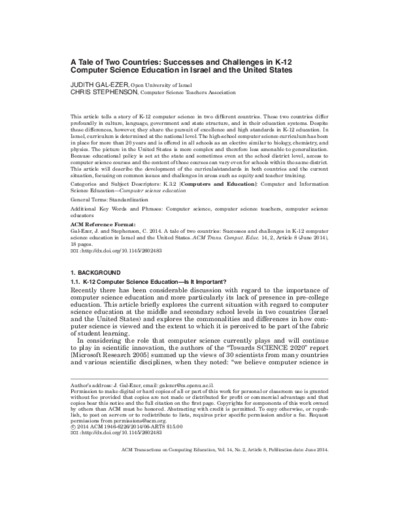A Tale of Two Countries: Successes and Challenges in K-12 Computer Science Education in Israel and the United States |
 |
 Zusammenfassungen
Zusammenfassungen
This article tells a story of K-12 computer science in two different countries. These two countries differ profoundly in culture, language, government and state structure, and in their education systems. Despite these differences, however, they share the pursuit of excellence and high standards in K-12 education. In Israel, curriculum is determined at the national level. The high-school computer science curriculum has been in place for more than 20 years and is offered in all schools as an elective similar to biology, chemistry, and physics. The picture in the United States is more complex and therefore less amenable to generalization. Because educational policy is set at the state and sometimes even at the school district level, access to computer science courses and the content of those courses can vary even for schools within the same district. This article will describe the development of the curricula/standards in both countries and the current situation, focusing on common issues and challenges in areas such as equity and teacher training.
Von Judith Gal-Ezer, Chris Stephenson im Journal ACM Transactions on Computing Education (TOCE) - Special Issue on Computing Education in (K-12) Schools (2014) im Text A Tale of Two Countries: Successes and Challenges in K-12 Computer Science Education in Israel and the United States  Dieser wissenschaftliche Zeitschriftenartikel erwähnt ...
Dieser wissenschaftliche Zeitschriftenartikel erwähnt ...
 Personen KB IB clear | Michal Armoni , R. N. Foster , Judith Gal-Ezer , Orit Hazzan , Tami Lapidot , Jane Margolis , Noa Ragonis , L. Shulman , Allen B. Tucker , Jeannette M. Wing , Adital Zeldes | |||||||||||||||||||||||||||||||||||||||||||||||||||||||||||||||
 Begriffe KB IB clear | Curriculum / Lehrplancurriculum
, greenfootgreenfoot
, Informatikcomputer science
, Informatik-Didaktikdidactics of computer science
, Informatik-Unterricht (Fachinformatik)Computer Science Education
, Informatikunterricht in der Schule
,  Schule Schule school school
| |||||||||||||||||||||||||||||||||||||||||||||||||||||||||||||||
 Bücher |
| |||||||||||||||||||||||||||||||||||||||||||||||||||||||||||||||
 Texte |
|
 Dieser wissenschaftliche Zeitschriftenartikel erwähnt vermutlich nicht ...
Dieser wissenschaftliche Zeitschriftenartikel erwähnt vermutlich nicht ... 
 Nicht erwähnte Begriffe | LehrerIn, Lehrplan 21, Unterricht |
 Tagcloud
Tagcloud
 Zitationsgraph
Zitationsgraph
 Zitationsgraph (Beta-Test mit vis.js)
Zitationsgraph (Beta-Test mit vis.js)
 Zeitleiste
Zeitleiste
 Anderswo finden
Anderswo finden
 Volltext dieses Dokuments
Volltext dieses Dokuments
 |  A Tale of Two Countries: Successes and Challenges in K-12 Computer Science Education in Israel and the United States: Artikel als Volltext ( A Tale of Two Countries: Successes and Challenges in K-12 Computer Science Education in Israel and the United States: Artikel als Volltext ( : :  , 118 kByte; , 118 kByte;  : :  2021-03-21) 2021-03-21) |
 Anderswo suchen
Anderswo suchen 
 Beat und dieser wissenschaftliche Zeitschriftenartikel
Beat und dieser wissenschaftliche Zeitschriftenartikel
Beat hat Dieser wissenschaftliche Zeitschriftenartikel während seiner Zeit am Institut für Medien und Schule (IMS) ins Biblionetz aufgenommen. Beat besitzt kein physisches, aber ein digitales Exemplar. Eine digitale Version ist auf dem Internet verfügbar (s.o.). Es gibt bisher nur wenige Objekte im Biblionetz, die dieses Werk zitieren.

















 Biblionetz-History
Biblionetz-History